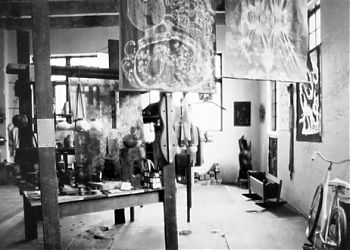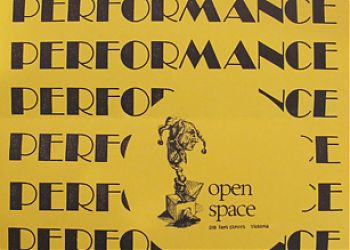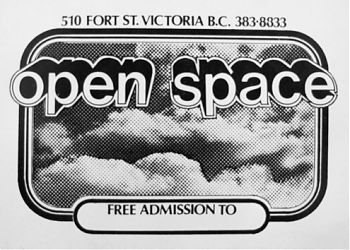
Gene Miller arrived in Victoria from New York in 1970, bringing with him the dream of starting up a coffee shop: a place for people to come together and share ideas and food. The idea germinated when Miller was a student at Goddard College in Vermont, but found grounds to grow in Victoria. Soon after his arrival, he met Gary Pogrow – also a former New Yorker – who shared his enthusiasm for establishing a creative gathering place. Together they developed the concept for Open Space: “an experiment whose themes are the city and citizens; street, neighbourhood and community; drama, education and culture.”1
After 6 months of spreading the word in the artistic and philanthropic communities and scouting out a building that would accommodate the concept, Miller and Pogrow found a warehouse located at 510 Fort Street in February of 1971. Luckily, they also found a patron in the landlord Geoff Sheffield, who invested $1000 in the concept and offered the space rent-free for the first year of operations. The artists negotiated a five-year lease and renovated the warehouse to comprise an artists’ coop/craft market and a restaurant on the first floor, and a flexible theatre studio that could be used for performances, workshops and screenings on the second floor. They were also provided access to the third floor of the adjoining warehouse at 506 Fort Street, which was converted into a studio-gallery used for exhibitions, chamber music recitals, rehearsals and other events requiring a more intimate atmosphere.
True to its name, Open Space fostered an environment where the facilities could be used for a variety of purposes and where adaptability and flexibility was favoured in terms of both infrastructure and programming. The theatre studio was hence designed as modular to accommodate the spatial needs of each project it hosted. Theatre was at the heart of Open Space’s concept and at the time no small-to-medium theatre space existed in the city apart from the Langham Court, home of the Victoria Theatre Guild. Activities began in the space in the late spring of 1971: a youth company directed by Don MacLean held rehearsals and workshops; Kaz Piesowocki, a former member of the Polish National Mime Troupe, led mime classes; and Peter Frisch, a theatre director from New York, directed a troupe formed of Victoria and New York based actors called the Open Space Ensemble.
On September 15 1972, the Greater Victoria Theatre Box Society was incorporated to administer Open Space, and Gene Miller took on the role of Artistic Director. At the time, Open Space’s programming was conceived both in-house and by inviting submissions and contributions from members of the local artistic community. In 1972 the centre’s programming included: weekly film screenings, Sunday evening chamber music recitals, public lectures presented in collaboration with the University of Victoria, and a noontime theatre program called Lunchbox Theatre. The Art Gallery of Greater Victoria then used the 506 Fort Street third floor studio as a satellite space. That year, Open Space organized a Christmas Craft Fair, and the initiative became a yearly rendez-vous for local artists and craft makers to sell work. The first Open Eye-Open Ear Festival took place between March 16 and April 9 1972, and attracted over 8000 visitors. More than 75 local artists exhibited work at the festival, which also featured the exhibition of a large collection of Chinese prints loaned by SFU, 30 wood sculptures by Montreal-based artist Charles Butler, and 19 performance events.
Like most artist-run spaces, Open Space’s early days were not without obstacles and controversy. The conversion of the 510 Fort Street warehouse into an artistic hive was the source of recurrent issues with the Fire Department, which deemed that the space did not conform to city regulations. In June of 1973, Gene Miller was prosecuted and found guilty on 4 charges of contravening with the Fire Marshall’s act and, in November of the same year, Open Space was shut down by the Fire Marshall because it did not meet Fire Code standards. Around the same time, Victoria’s Mayor, Peter Pollen, publicly condemned Open Space for the poster of the exhibition Some Drawn Conclusions, which contained a small close-up photograph of female genitalia. Pollen denounced the poster’s content and warned of its potential impact on Open Space’s future funding applications to the City. An “anti-establishment” art centre was not welcomed by all in the then more conservative Victoria community, and it took a few years for Open Space to be accepted by the local population.
By 1974 however, Open Space was operating with funding from the provincial government, the inter-municipal committee, and the Canada Council. Having seen his project develop from a burgeoning idea to a sustainable endeavour, Gene Miller resigned as Artistic Director. Bill Bartlett, who was the Director of the Northwest Coast Institute of the Arts – an artist-run school incidentally located at 506 Fort Street – took over and shifted Open Space’s programming focus to visual arts. With exhibitions now being at the heart of Open Space’s activities – although screenings of local and international films, poetry readings and theatre and music performances were still part of regular programming – the space became eligible to receive funding through the newly created Canada Council Aid to Artist-Run Centres program. In 1976, Open Space had raised enough money, through both public and private channels, to purchase the 510 Fort Street warehouse it had been occupying for the past five years. The space underwent transformation: the first floor was rented to a commercial tenant and the second-floor’s multi-use theatre studio was converted into a flexible gallery space. In 1977 the Theatre Box Society officially changed its name to Open Space.
Open Space was one of the first members of ANNPAC, and is today the oldest artist-run centre in BC. For the past four decades, the centre has fostered experiments in visual art, performance, music and new media. Video art appeared in the centre’s programming activities in the late 1970s with Peggy Cady’s series of Video Lunches (1977-78) and the broadcast of independent video art on cable television (1979). Bill Bartlett and John Celona’s Collaboratory (1978) introduced new music to the centre’s programming, and the project Sat-Tel-Comp (1978), telematic video transmission utilizing satellite technology, propelled Open Space’s contributions to developments in new media. In the 1980s, Open Space began presenting site-specific projects including Diane Burgoyne’s Digital Body, an interactive performance involving electronic sound that was presented on the UVic campus. The centre’s late 1980s and early 1990s programming focused on the presentation of political art and provided exposure to marginalized groups. In the late 1990s and early 2000s, Open Space expanded the reach of its activities through the web by presenting programming on its website as of 1998 and by initiating href=“http://openspace.ca/node/908”>Audiospace in 2003, a bi-annual web-based audio art project. Today, Open Space maintains the flexibility and openness that characterized its early days by supporting experimental artistic practices in all contemporary arts disciplines, acting as a laboratory for engaging art, artists, and audiences.
Founding Artists:
Gene Miller
Garry Pogrow
Board of Directors at time of Incorporation:
Eugene Miller
Michael Stephen
Edward Gould
Peter Cotton
Grant Holland
Date of Incorporation:
September 15, 1972
Greater Victoria Theatre Box Society Constitution:
The objects of the Society are:
a) To promote interest in and the study of the arts generally and literature, drama and music in particular;
b) To advance the knowledge and appreciation of and to stimulate interest in dramatic culture and tradition by theatrical performances and otherwise;
c) To provide facilities for education and instruction in the arts of the theatre;
d) To provide improved opportunities for artistic talent;
e) To advance the developments of the arts of the theatre;
f) For the objects aforesaid to acquire and construct such property as may be required;
g) To collect moneys by way of fees, donations or otherwise;
h) To conduct Festivals at various centres; and accept gifts, legacies, devises and bequests, and to hold, invest, expend or deal with the same in furtherance of the objects of the Society;
i) To acquire and take by purchase, lease, devise, or otherwise hold for the use of the Society all kinds of interests in real and personal property in the Province of British Columbia.
Open Space Locations:
1971 to 1976 – 510 Fort Street and 3rd floor of 506 Fort Street
1976 to present – 510 Fort Street
Open Space Publications:
An index of publications produced by Open Space can be found here and through the Repertoire of BC ARC Publications here.
Relevant Archives:
Open Space houses boxes and binders containing archival material related to exhibition and organizational history that can be viewed at the gallery by appointment. A documented chronology of exhibitions and events presented at Open Space since 1972 can be accessed here.








